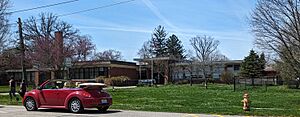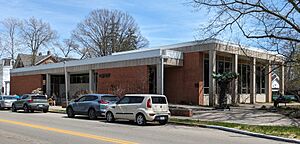Yellow Springs, Ohio facts for kids
Quick facts for kids
Yellow Springs, Ohio
|
|
|---|---|
|
Village
|
|
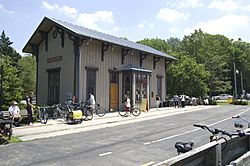
Former railroad station
|
|
| Motto(s):
Find Yourself Here
|
|
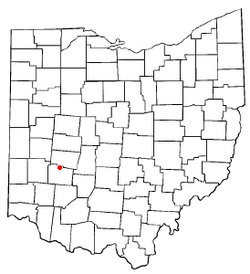
Location of Yellow Springs, Ohio
|
|
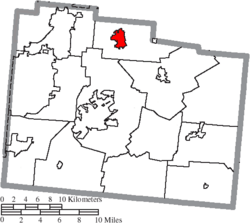
Location of Yellow Springs in Greene County
|
|
| Country | United States |
| State | Ohio |
| County | Greene |
| Area | |
| • Total | 2.75 sq mi (7.13 km2) |
| • Land | 2.75 sq mi (7.13 km2) |
| • Water | 0.00 sq mi (0.00 km2) |
| Elevation | 1,020 ft (310 m) |
| Population
(2020)
|
|
| • Total | 3,697 |
| • Density | 1,343.39/sq mi (518.73/km2) |
| Time zone | UTC-5 (Eastern (EST)) |
| • Summer (DST) | UTC-4 (EDT) |
| ZIP code |
45387
|
| Area code(s) | 937, 326 |
| FIPS code | 39-86940 |
| GNIS feature ID | 2399752 |
| Website | yso.com |
Yellow Springs is a small village located in northern Greene County, Ohio, United States. In 2020, about 3,697 people lived there. It is part of the larger Dayton metropolitan area. Yellow Springs is also home to Antioch College, a well-known school.
Contents
History of Yellow Springs
The village of Yellow Springs was started in 1825. A man named William Mills and about 100 families founded it. They wanted to create a special community, like a utopian (perfect) society. They were inspired by a similar community in Indiana.
The village got its name from nearby natural springs. The water in these springs had a lot of iron, which gave the rocks a yellowish-orange color. People in the 1800s believed these spring waters had healing powers.
In 1846, the Little Miami Railroad was finished. This brought more trade, people, and tourists to the area. Yellow Springs officially became a village in 1856.
Antioch College's Story
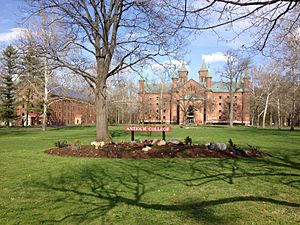
Antioch College was founded in 1850 and opened its doors in 1853. Its first president was the famous scholar Horace Mann.
In 1920, Arthur E. Morgan became the college president. He was known for new ideas, like a work-study program for students. This program allowed students to work while they studied. Morgan later led the Tennessee Valley Authority for President Franklin D. Roosevelt.
The Antioch Company was started in 1926 by two Antioch College students. It first sold bookplates, then expanded to children's books and gifts. The company later focused on scrapbooking items. Its Yellow Springs location closed in 2012.
Antioch College grew a lot in the 1960s and 70s. It had many locations across the country. However, in 1986, most of these locations closed. The original campus in Yellow Springs continued to operate.
In 2008, the college campus in Yellow Springs closed due to money problems. But former students bought back the college's name and campus. They reopened it in 2011 as an independent school. Today, Antioch University and Antioch College are completely separate schools.
Freed Slaves in Yellow Springs
In 1862, a group of 30 freed slaves, known as the Conway Colony, settled in Yellow Springs. They were brought there by Moncure D. Conway, an abolitionist.
Wheeling Gaunt, a former slave who bought his own freedom, came to Yellow Springs in the 1860s. By the time he died in 1894, he owned a lot of land. Gaunt left a large piece of land to the village. He asked that the money from renting this land be used to buy flour for the "poor and worthy widows" of Yellow Springs.
The land was used to create Gaunt Park, so it doesn't make rent money. However, the village still gives flour and sugar to the village's widows each Christmas. This is a special tradition that often gets attention from the news.
Community Activism
Yellow Springs has a history of supporting fairness and social change. In the 1950s, during a time called the Red Scare, some people worried about the political views of those in Yellow Springs and at Antioch College. However, the college president stated that Antioch believed in academic freedom. This meant the right to explore all ideas.
In the late 1960s and early 1970s, Yellow Springs became a center for the Civil Rights Movement. It also supported the anti-war movement in Ohio. People in the village still tend to have progressive (forward-thinking) political views. This makes Yellow Springs unique in a mostly conservative part of the state.
In 1979, Yellow Springs was the smallest town to pass a law against discrimination based on sexual orientation. This means the village made it illegal to treat people unfairly because of who they love. By 2014, it had a large LGBT population compared to other villages in Ohio.
Yellow Springs Geography
The village covers about 2.02 square miles (5.23 square kilometers) of land.
Yellow Springs gets its name from a natural spring nearby. The water from this spring is rich in iron. This leaves a yellowish-orange color on the rocks around it. This spring is now part of the Glen Helen Nature Preserve. In the mid-1800s, it was a popular resort. Many people visited, believing the spring water had health benefits.
Population Information
| Historical population | |||
|---|---|---|---|
| Census | Pop. | %± | |
| 1850 | 138 | — | |
| 1860 | 1,319 | 855.8% | |
| 1870 | 1,435 | 8.8% | |
| 1880 | 1,377 | −4.0% | |
| 1890 | 1,375 | −0.1% | |
| 1900 | 1,371 | −0.3% | |
| 1910 | 1,360 | −0.8% | |
| 1920 | 1,264 | −7.1% | |
| 1930 | 1,427 | 12.9% | |
| 1940 | 1,640 | 14.9% | |
| 1950 | 2,896 | 76.6% | |
| 1960 | 4,167 | 43.9% | |
| 1970 | 4,624 | 11.0% | |
| 1980 | 4,077 | −11.8% | |
| 1990 | 3,973 | −2.6% | |
| 2000 | 3,761 | −5.3% | |
| 2010 | 3,487 | −7.3% | |
| 2020 | 3,697 | 6.0% | |
| U.S. Decennial Census | |||
In 2010, there were 3,487 people living in Yellow Springs. There were 1,672 households. About 25.4% of households had children under 18. The average household had 2.04 people.
The median age in the village was 48.5 years old. About 19.7% of residents were under 18. About 21.6% were 65 or older.
Arts and Culture in Yellow Springs
Yellow Springs has a lively arts community for its size. Several places in Yellow Springs are listed on the National Register of Historic Places. These include Antioch Hall, North and South Halls, South School, and the Yellow Springs Historic District.
Young's Jersey Dairy is a family farm and restaurant. It has fun attractions like batting cages, miniature golf, and a petting zoo.
Local arts groups include:
- Yellow Springs Arts Council
- Yellow Springs Theater Company
- Chamber Music Yellow Springs (CMYS)
- The World House Choir
- The Yellow Springs Community Chorus
- The Yellow Springs Chamber Orchestra
- The Yellow Springs Community Band (YSCB)
- Yellow Springs Strings (Senior Orchestra)
Parks and Recreation

Yellow Springs is close to many parks and natural areas. These include the Glen Helen Nature Preserve, the Little Miami Bike Trail, John Bryan State Park, and Clifton Gorge State Nature Preserve.
The Village of Yellow Springs also owns several parks. The largest is Gaunt Park, which has two baseball fields and a swimming pool. North of the village is Ellis Park, with a picnic area and a pond. There are also smaller neighborhood parks throughout the village.
Education in Yellow Springs
The Yellow Springs Exempted Village School District runs three schools:
- Mills Lawn Elementary
- McKinney Middle School
- Yellow Springs High School
The only private elementary school is the Antioch School. It is a democratic school for students from preschool to sixth grade. It was started by Arthur Ernest Morgan.
Antioch College, a private liberal arts college, was founded here in 1850. Yellow Springs also used to be home to Antioch University Midwest. This school closed in 2020. However, Antioch University's main offices are still in Yellow Springs.
Yellow Springs has a public library. It is a branch of the Greene County Public Library.
Media in Yellow Springs
Yellow Springs is home to WYSO, a public radio station. It is a member of National Public Radio. WYSO became independent in 2019, but still works with Antioch College. College students can intern there.
Local news and events are covered by the Yellow Springs News. This is an independent weekly newspaper.
Notable People from Yellow Springs
- Paul Abels, clergyman
- Noah Adams, public radio journalist and author
- Arnold Adoff, poet and author
- Cindy Blackman, jazz/rock drummer
- Dave Chappelle, American comedian and actor
- Suzanne Clauser, screenwriter and novelist
- Mike DeWine, current Governor of Ohio
- Monica Drake, editor at the New York Times
- Jewel Freeman Graham, educator and social worker
- Richie Furay, singer and songwriter
- Virginia Hamilton, children's author
- Anne Harris, musician and actor
- Jon Barlow Hudson, sculptor
- Mike Kahoe, baseball player
- Coretta Scott King, civil rights leader
- John Lithgow, actor
- Neal Vernon Loving, racing pilot and engineer
- Trace Lysette, actress
- Michael Malarkey, actor and musician
- David Nibert, sociologist and animal rights activist
- Catherine Roma, choral conductor
- David Wilcox, American folk musician
- Julia Reichert, documentary filmmaker
See also
 In Spanish: Yellow Springs (Ohio) para niños
In Spanish: Yellow Springs (Ohio) para niños



